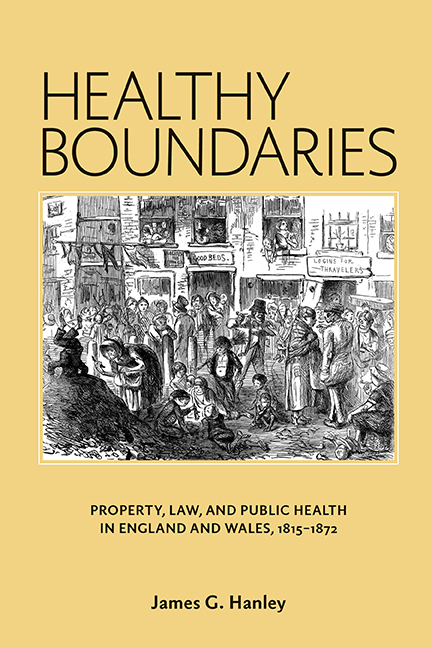Book contents
- Frontmatter
- Dedication
- Contents
- Acknowledgments
- Abbreviations
- Introduction
- 1 The Laws of Nuisance Before 1846: Property, Health, and Democracy in the Age of Reform
- 2 Private Benefit and Public Service: Paying for Sewers Before 1848
- 3 The Boundaries of Health, 1848–70
- 4 The Benefits of Health: London, 1848–65
- 5 Healthy Domesticity, 1848–72
- Conclusion
- Notes
- Bibliography
- Index
1 - The Laws of Nuisance Before 1846: Property, Health, and Democracy in the Age of Reform
Published online by Cambridge University Press: 07 May 2022
- Frontmatter
- Dedication
- Contents
- Acknowledgments
- Abbreviations
- Introduction
- 1 The Laws of Nuisance Before 1846: Property, Health, and Democracy in the Age of Reform
- 2 Private Benefit and Public Service: Paying for Sewers Before 1848
- 3 The Boundaries of Health, 1848–70
- 4 The Benefits of Health: London, 1848–65
- 5 Healthy Domesticity, 1848–72
- Conclusion
- Notes
- Bibliography
- Index
Summary
The following chapters make three principal claims. First, critical aspects of public health in nineteenth-century Britain, from the initial development of the health hazard to the liability of property for drainage, were driven as much by lay as professional people. Disease, especially epidemic disease, played a fundamental role, but the attempt to avoid disease was directed largely by local elites, only some of whom had medical training or relied on medical knowledge. Second, more important to these early developments than medicine was property. Public health and property were mutually constitutive, and the evolution of laws around public health cannot be understood apart from the concepts of property they were intended to inflect. A third claim is that we hear this healthproperty dialogue most clearly if we listen to local rather than central government actors, because local actors, including metropolitan actors, made many of the important decisions and forged many of the crucial concepts. Indeed, the central government was ambivalent about local experimentation.
The early development of the statutory health hazard is an example of this picture of public health. In 1846, Parliament created the first national statutory health hazard. The statutory health hazard remains one of the two limbs of British statutory nuisance law today. This law was passed in anticipation of a cholera epidemic and marked the third time Parliament or the central government responded to cholera by identifying a health hazard. Cholera was not the act's sole central inspiration, and passage of the law was also likely linked to a series of developments relating to the establishment of the early English public health movement. Foremost among these developments in the central government was Edwin Chadwick's inquiry (1839–42) into the sanitary condition of the laboring classes. In his Report on the Sanitary Condition of the Labouring Population of Great Britain, Chadwick argued that decaying animal and vegetable material was a primary cause of much surplus death, and these materials ended up being identified as health hazards.
In recent years, historians less inclined to take Chadwick's version of public health for granted have challenged this experiential and empirical account of the creation of the sanitary nuisance.
- Type
- Chapter
- Information
- Healthy BoundariesProperty, Law, and Public Health in England and Wales, 1815–1872, pp. 17 - 38Publisher: Boydell & BrewerPrint publication year: 2016



